Opticron Verano BGA HD Binocular: Short Review
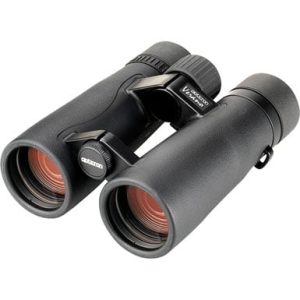 Pros: Excellent image quality from a mid range binocular that packs plenty of optical punch. Bright, sharp view with great detail even in low light and outstanding close focus. Low weight and good balance a bonus in the field.
Pros: Excellent image quality from a mid range binocular that packs plenty of optical punch. Bright, sharp view with great detail even in low light and outstanding close focus. Low weight and good balance a bonus in the field.
Cons: Design feels a little unrefined for a binocular that’s far from cheap. Overall package is let down slightly by sub-par accessories. Case was just nasty; tethered objective covers felt flimsy, were loose and fell off several times in the field; rain-guard basic but functional.
Price: €550 – €600
Value: Good
Rating: Recommended
If you’re looking for a new pair of wildlife watching or birding binoculars the Opticron Verano BGA HD is a worthy contender for your shortlist. Optically excellent, but with handling that may take a bit of getting used to: try a pair for yourself.
View the Verano BGA HD Product Page on Opticron’s Website
Opticron Verano BGA HD Binocular: Full Review
I’ve always quite liked Opticron as a brand, particularly their commitment to bringing quality optics to the market at affordable prices. The better binoculars in the Opticron range aren’t cheap by any stretch… but they do tend to offer high spec optical performance at a more affordable price point than some premium binocular brands.
I’ve had the opportunity to look through several different Opticron models in the past, and have always been quite pleased with the view. I own a pair of Opticron compact binoculars “for emergencies” , and for compacts I have to say they perform admirably. Until recently though I’d never had chance to put a decent set of full size Opticrons through their paces for an extended period in the field.
That changed a couple of weeks ago, when the 8×42 flavour of the Opticron Verano BGA HD arrived at Ireland’s Wildlife HQ.
Opticron Verano BGA HD Binoculars: What’s in the box?
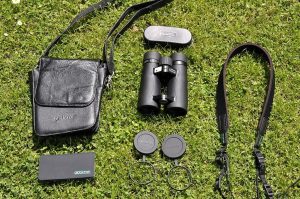 The new Verano HDs arrived in a standard black cardboard box. Along with the binoculars were the usual assortment of accessories: soft leather-esque case, neoprene neck strap, generic instruction card, eyepiece rain guard detachable tethered objective covers and a micro-fibre cleaning cloth.
The new Verano HDs arrived in a standard black cardboard box. Along with the binoculars were the usual assortment of accessories: soft leather-esque case, neoprene neck strap, generic instruction card, eyepiece rain guard detachable tethered objective covers and a micro-fibre cleaning cloth.
First impression: binocular
There’s no doubting that the Verano is a solid piece of kit. It feels well made, and has a comfortably substantial heft without feeling heavy. You get the feeling it will stand up well to the rigours of extended use out in the field. The design follows the in-vogue dual-hinged open bridge design that’s become so popular today. The tough polycarbonate body is enclosed in a thin coating of quite hard, lightly textured black rubber armour that affords both added protection and, crucially, a better grip on the binocular barrel.
The “Recommended by BTO” sticker on the upper hinge would probably be the first thing to go if these were my binoculars, but an endorsement from such a well respected authority is a very positive thing. It adds to your confidence that your new Veranos are going to perform where and when it matters most: out in the field.
First impressions: accessories
The accessories included with the Verano are a bit of a mixed bag to be honest.
Speaking of bags I absolutely loathed the soft case that comes with these binoculars. It looked and felt like horribly synthetic faux-leather, although Opticron assures me that it is, in fact, made out of pig skin. Regardless of what it was made of, to me it screamed “cheap and nasty” when the Veranos are anything but. Perhaps it’s a personal thing: you might like that “thin shiny plastic” look, but to me it simply didn’t marry up with the quality of the Veranos.
So the case looks awful, but does its job well enough. The binoculars fit snugly and the bag closes without having to straighten the hinge or lower the eyecups. As with so many modern binoculars though there doesn’t seem to be room to fold the strap into the case and still close the flap. The padding on the case is minimal… so it’s a good job the binoculars feel robust enough to withstand a few knocks.
Thankfully the case is probably the least important piece of equipment in the box. If you’re using a binocular regularly (and when you’re spending this much that’s quite likely), you’re not going to have too much use for the case.
The other accessories fare a little better — the rain guard is a very plain plastic cover that again doesn’t seem to match the quality level of the binocular it’s paired up with — but it’s a very utilitarian piece of kit that performs well. It covers the eyepieces quickly regardless of the angle you have the hinges set at, and flicks off easily when you want to look at something. It does the job… but it doesn’t really look the part.
Tethered objective lens covers are now pretty standard, and the ones that come with the Verano’s are very similar to those that you’ll find with most binoculars of this type. However, they do feel a bit flimsy, and the fit of both the tethered rubber ring and the covers themselves is a little on the loose side. Several times I put them down only to find that one or both objective covers had fallen open when I went to pick them up again. Not that big a deal… until your expensive optics get scratched I suppose. More serious was the fact that several times over the two weeks I was testing them I had to retrace my steps to find an objective cover that had fallen off the binocular in the field… and that’s far from ideal.
The strap is quite a thick neoprene strip about 3cm wide along its entire length. It’s comfortable, with just the right amount of give to cushion the weight of the Veranos. I tend to prefer straps that flare to offer wider support at the back of the neck, but really I have no complaints with the Verano strap — it’s functional, the finish is good, and I really like the “quick release” buckles that make it easy to detach the strap from the binoculars without having to unthread the webbing.
Finally… there’s the cleaning cloth. Opticron’s Professional Series Ultrafine Microfibre Cleaning Cloth, no less, comes in its own little protective wallet and it is superb. The cleaning cloth is a relatively small but very important part of the package: a good one makes keeping your fine new optics in tip-top condition that much easier.
I can’t help thinking that if Opticron had matched the quality of the rest of their accessories to the quality of the cleaning cloth they’d have a much more polished package on their hands for very little extra cost. C’est la vie!
Handling and balance
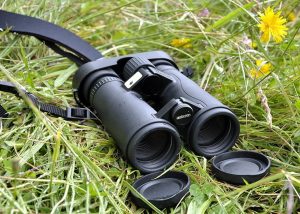 While the new Veranos are relatively light and well balanced, and feel comfortable in the hand when you pick them up, I struggled a little with them at first. I’ve never been a huge fan of the dual-hinge design, and it felt awkward and unwieldy. Couple that with a slightly finicky interpupillary distance (IPD) adjustment and it took me a while to get used to the Veranos.
While the new Veranos are relatively light and well balanced, and feel comfortable in the hand when you pick them up, I struggled a little with them at first. I’ve never been a huge fan of the dual-hinge design, and it felt awkward and unwieldy. Couple that with a slightly finicky interpupillary distance (IPD) adjustment and it took me a while to get used to the Veranos.
With the IPD at the physically most comfortable setting for my eyes I got crescent shaped blackouts on the periphery of the image while panning. Shifting the IPD in slightly resolved the problem, giving a perfect circular view, but at the compromise of reduced comfort holding the binoculars to my eyes. This is likely to be a purely personal foible — and one of the reasons why, with binoculars, it always pays to try before you buy.
The twist-up eyecups are metal covered in similar rubber armour to the binocular body. They offer four possible positions — fully up, fully down and two intermediate positions that “click” into place. They allow a substantial maximum eye-relief of 22mm — which in practice means that spectacle wearers should have no trouble getting the maximum field of view.
My initial reservations with the open hinge design soon evaporated after using the binoculars for a few days, and I found them very comfortable to carry, hold and use once they were set up correctly. I still struggled to find the ideal IPD for my eyes though if someone else had used the Veranos and changed the setting.
Focusing
No complaints here… the focus mechanism on the Veranos is smooth and consistent throughout the one-and-a-half anti-clockwise turns from close-focus to infinity. The slightly knurled focus wheel offers good grip, and there’s a comfortable amount of resistance as you turn it without any sign of “play” or looseness in the mechanism. Accurate, pin-sharp focusing is both quick and easy to achieve. Top marks to Opticron here.
Close focus performance is excellent — I could comfortably focus and use the binoculars comfortably within the specified 2m range — making these ideal binoculars for butterflies, dragonflies and other insects.
The dioptre adjustment sits in its familiar location just beneath the right hand eyepiece. It is stiff, but smooth, and while there’s no locking mechanism, there is plenty of resistance to ensure it doesn’t move unintentionally.
Optical Performance
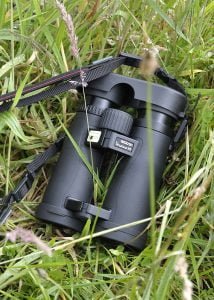 Once they’re set up properly the image through the Veranos is very impressive.
Once they’re set up properly the image through the Veranos is very impressive.
They utilise Opticron’s PGK glass prisms (I haven’t been able to find any information on what PGK glass means, and suspect it’s marketing blurb for the better quality BAK4 glass typically used in high-end binocular prisms) with phase correction and Opticron’s proprietary “Oasis” prism coatings to improve colour fidelity, light transmission and image sharpness.
Coupled with Optictron’s F-Type multi-coating on all air-to-glass surfaces the result is clear, sharp images with plenty of fine detail almost all the way to the edge — with slight softening towards the outer 10% or so, which is excellent. The view through the Verano BGA HD compares well in good light with binoculars that cost considerably more, and continues to impress even when the light fades.
I brought them along to twitch a Savi’s warbler at Tacumshin in Co. Wexford at the end of June. Scanning the reed beds at first light I was genuinely impressed with the amount of fine detail the Verano’s were able to extract from the subdued scene. They couldn’t match the performance of top-end bins being toted by many of the birders present — but they came surprisingly close. Passing them around the gathered throng brought a general chorus of surprised approval.
Field of view
The field of view at 7 degrees (144m at 1000m) is good, but nothing exceptional for an 8×42. Somehow it doesn’t feel as expansive and immersive as it should do either. Compared side-by-side the view through a pair of high-end 10x binoculars with a field of view of 6.3 degrees felt wider. It wasn’t, if you measured it using points of reference in the scene, but it felt like it was. Very odd.
Good performance, rain or shine
One of the things you need to know when you’re buying binoculars for use in Ireland or Britain is that they’re going to deliver consistent performance across a wide range of environmental conditions. We’ve already established that the Verano BGA HD is solid and robust, so it should handle the occasional knock. It’s also fully waterproof to 3m and nitrogen purged, so rain is no bother, and it won’t fog up in cold and damp conditions, or when moving between different temperature gradients (warm car to freezing estuary back to warm car, for example).
I tested the Opticrons in all of the conditions a particularly soggy Irish summer could throw up. They performed admirably, taking the wet in their stride, and doing a good job of controlling flare and internal reflection on the few occasions when the sun did put in an appearance. Low light performance was impressive, and the resolution, detail and colour fidelity were top notch across the board. Chromatic aberration (colour fringing) was well managed in the large central sweet spot and moderate right towards the edge. It was only visible as a slight green fringe when I actively looked for it when pointing the bins at extremely high-contrast subjects, otherwise it wasn’t noticeable at all.
10-30 year limited warranty
Opticron is obviously willing to stand over the quality of its Verano BGA HD, offering a 30 year warranty on the product for defects in material or workmanship — the first 10 years covering parts and labour, the following 20 covering parts only, with chargeable labour.
When is HD not HD?
The HD designation is widely used in the optics world to signify the use of High Density / Fluorite / Extra Low Dispersion (ED) glass in the optical system. Don’t ask me how it works, but this high performance glass supposedly plays a part in improving light transmission, resolution and colour fidelity. It tends to be expensive to produce, adds considerably to the price of optics that utilise it, and is usually only found in higher end models.
Leica’s Ultravid HD range, Swarovski’s SLC HD, Vortex Viper HD and Bushnell Legend Ultra HD all refer to binoculars containing this high-performance glass in their optical system.
You’d be forgiven, then, for assuming that the Opticron Verano BGA HD also contains this special glass. But it doesn’t!
The HD is simply a differentiator chosen arbitrarily by Opticron’s marketing team to denote an upgrade to the optical system compared to the previous Verano model.
This post from an Opticron representative on a Bird Forum thread published before the Verano HD was officially released explains things:
You are correct – the Verano HD does not have ED glass and we’ve never advertised or promoted it as such. It is an improvement over the current Verano due to the adoption of the superior optics of the Imagic BGA SE.
As far as I know, ED does not mean ‘high definition’ by any yardstick. ED glass simply helps reduce chromatic aberration. HD is term that we’ve all become familiar with because of the proliferation of HD television. This did indeed offer a resolution improvement over SD or standard definition TVs. And it was easy to measure – SD had 480 or 576 lines of resolution and HD has 720 (HD Ready) or 1080 (full HD*) of resolution.
Those that chose the HD moniker in the sports optics market to promote against ED chose to do so at their own risk. We’ve simply chosen to use the letters to denote a change and improvement in the sharpness/resolution, colour rendition and overall performance of a particular product range.
The new Veranos definitely deliver a very bright, clear, high resolution image — just be aware that they don’t employ ED glass to do so.
Summary
The Opticron Verano BGA HD is a very capable binocular that delivers consistently high optical performance across a wide range of field conditions. It is relatively compact and lightweight for a full size binocular, yet is robust and well made.
In terms of balance and handling, for me it took a bit of getting used, but once I’d grown accustomed to its idiosyncrasies I grew to quite like it — and the view — which is what really matters — was invariably excellent.
The quality of the accessories really don’t match the quality of the optics they support. Its something that detracts from the perception of the overall package — and it’s an area where Opticron could make substantial improvements very easily.
All in all the Verano BGA is a worthy contender for your shortlist if you’re looking for a full size birding and wildlife binocular in this price range, and is well worth taking a look at / through if you get the chance.
Opticron Verano BGA HD Product Specification
Taken from the Opticron Website:
| Specifications | 8×32 | 8×42 | 10×42 |
|---|---|---|---|
| Product Code Field (m) Min Focus (m) Eyerelief (mm) IPD (mm) HxW (mm) Weight (g) Price £ inc. VAT |
30600 140 1.5 17 56~74 128×122 609 429.00 |
30601 122 2 22 56~74 152×128 739 439.00 |
30602 113 2 21 56~74 152×128 738 449.00 |
Acknowledgement
I’d like to thank Opticron for submitting the Verano BGA HD for review on Ireland’s Wildlife.
NB. Ireland’s Wildlife has no specific affiliation to any optics or gear manufacturer and all reviews on the site are completely independent and objective. If you’re an optics or gear manufacturer and would like to submit your product for review on the site please drop us a line using the contact form and we can take things from there.



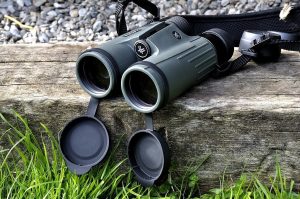






2 comments
Gavin
Do you know what the dial is on one of the eyepieces is? And why it’s only on one eyepiece?
Calvin
Hi Gavin…. thanks for your comment.
Yes… that’s the dioptre adjustment — it allows you to adjust the binocular to account for differences between your two eyes.
Here’s how you set it:
That’s it — your binoculars are now set for your eyes and you should be able to achieve sharp focus using only the central focusing wheel.
The reason you only need a dial on one side is that the dioptre adjustment is just compensating for the differences between your eyes. Once that’s set on one eyepiece you can focus the binocular accurately for both eyes using just the central focusing wheel.
Hope that makes sense.